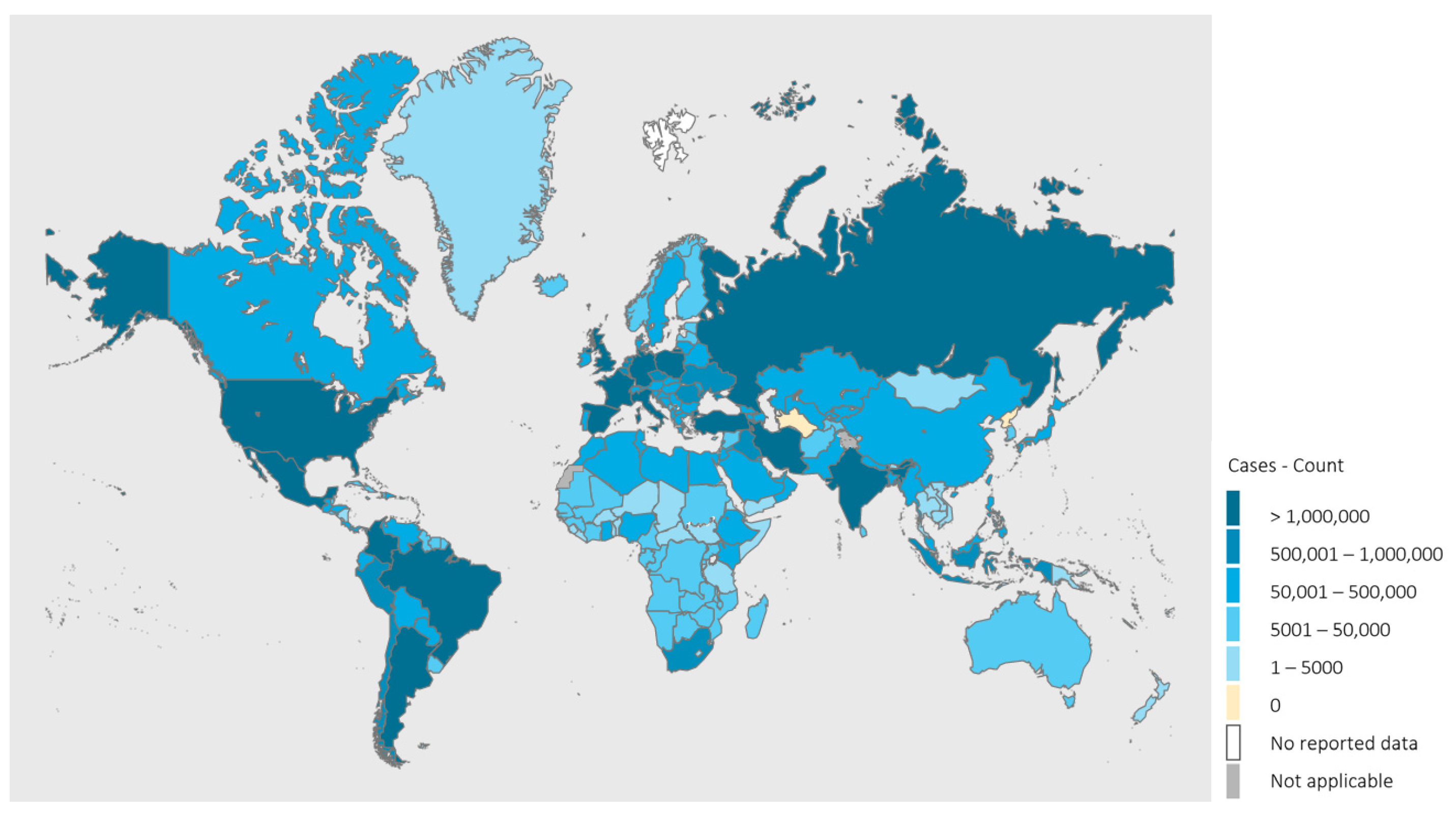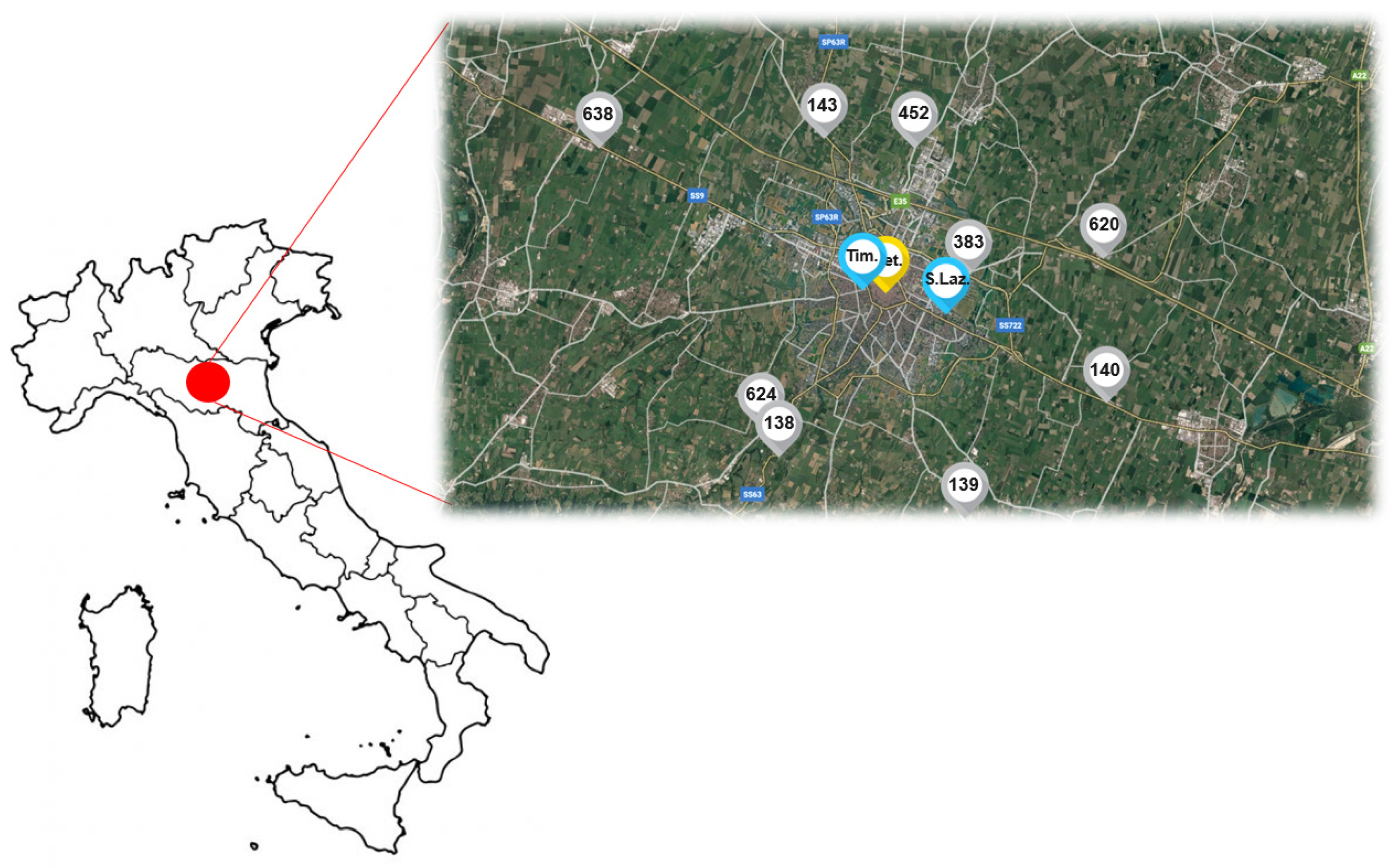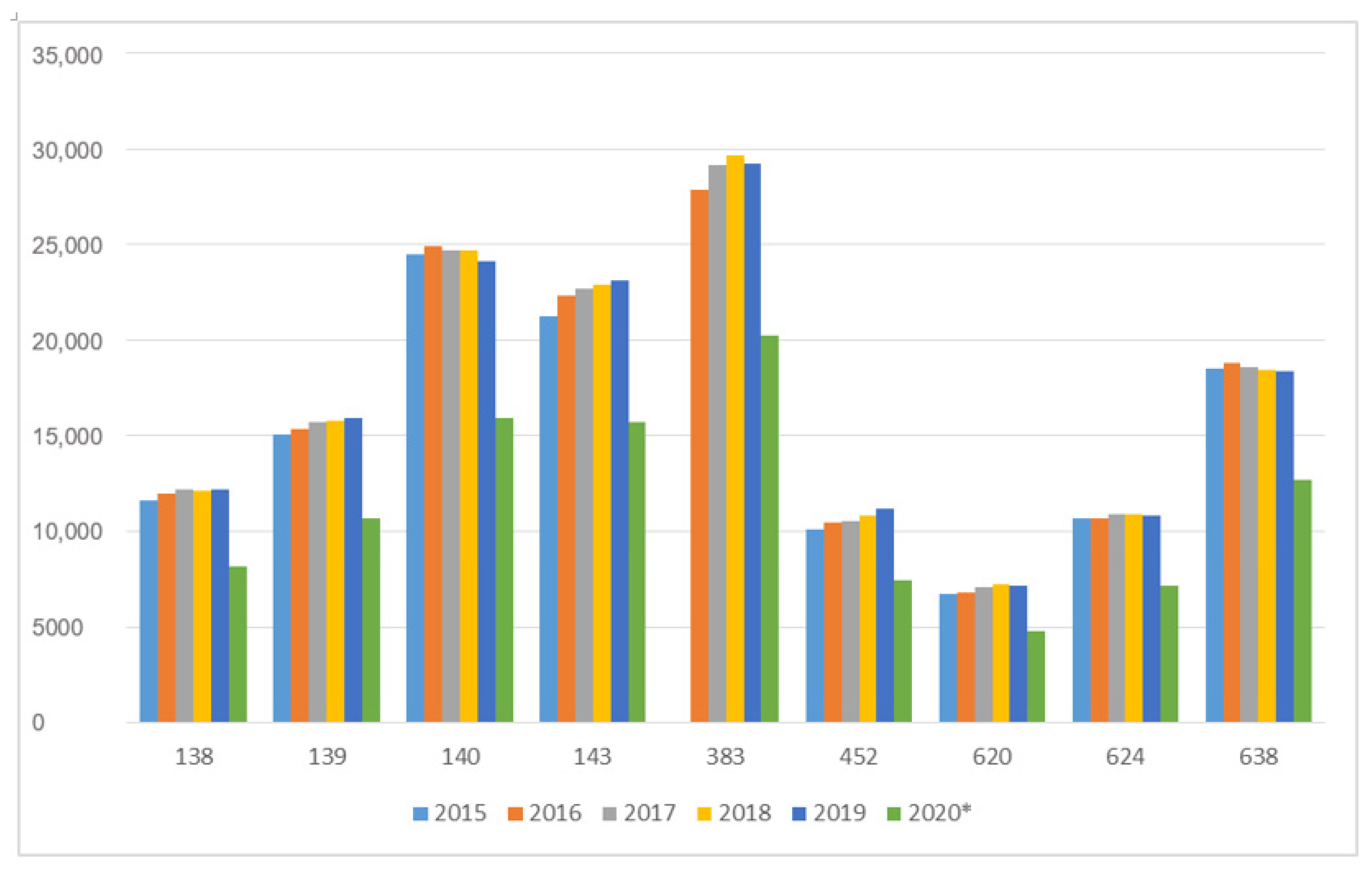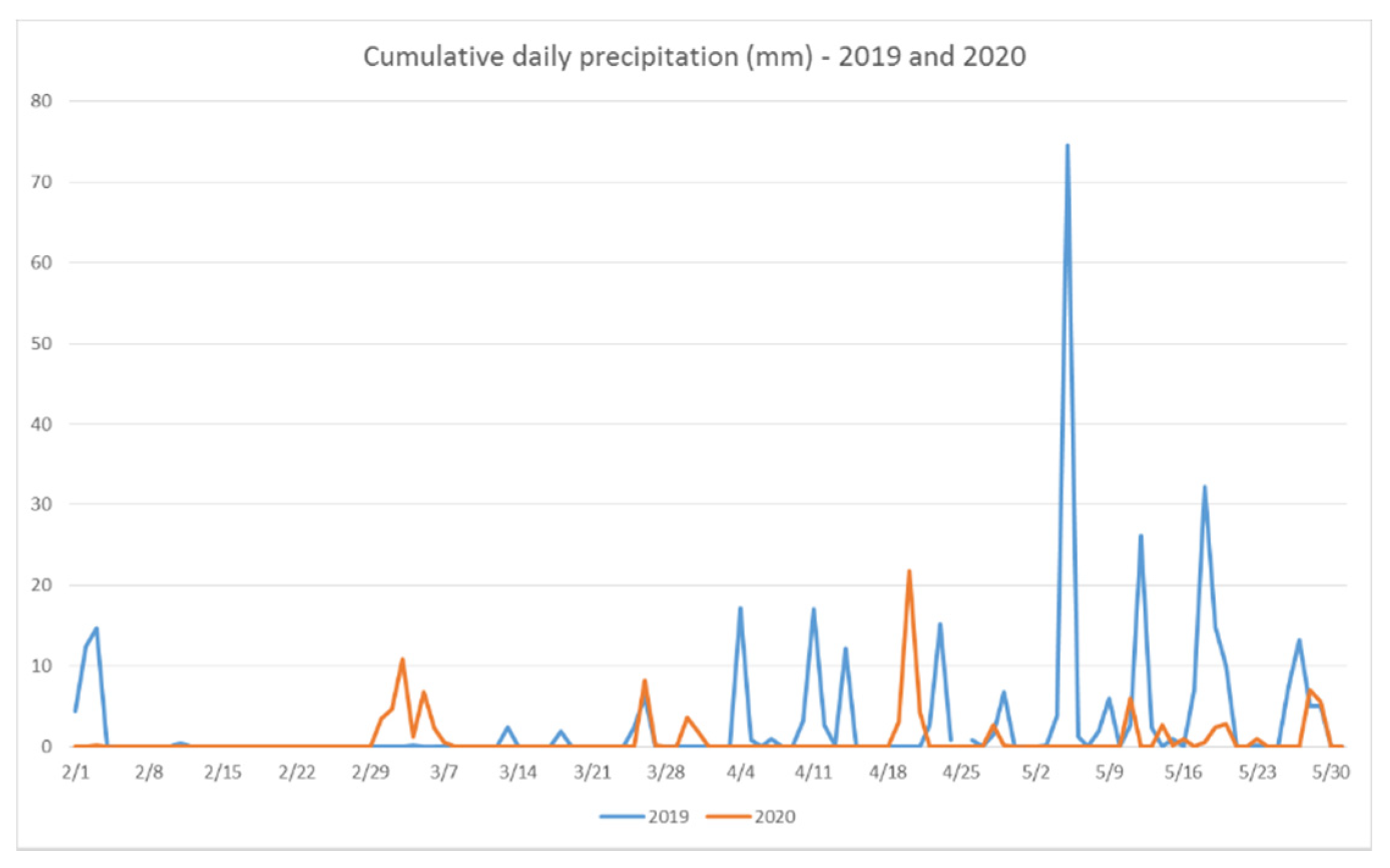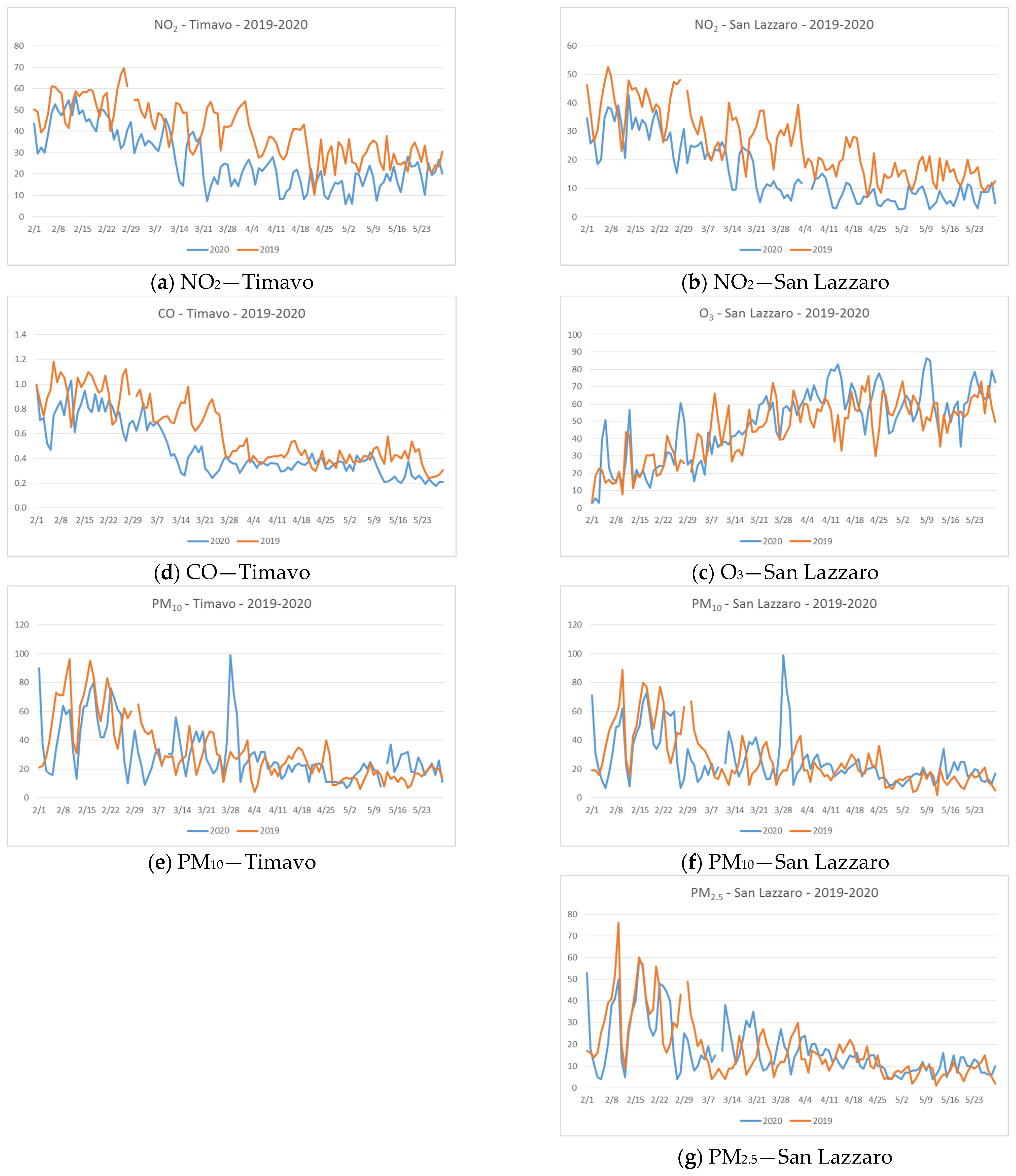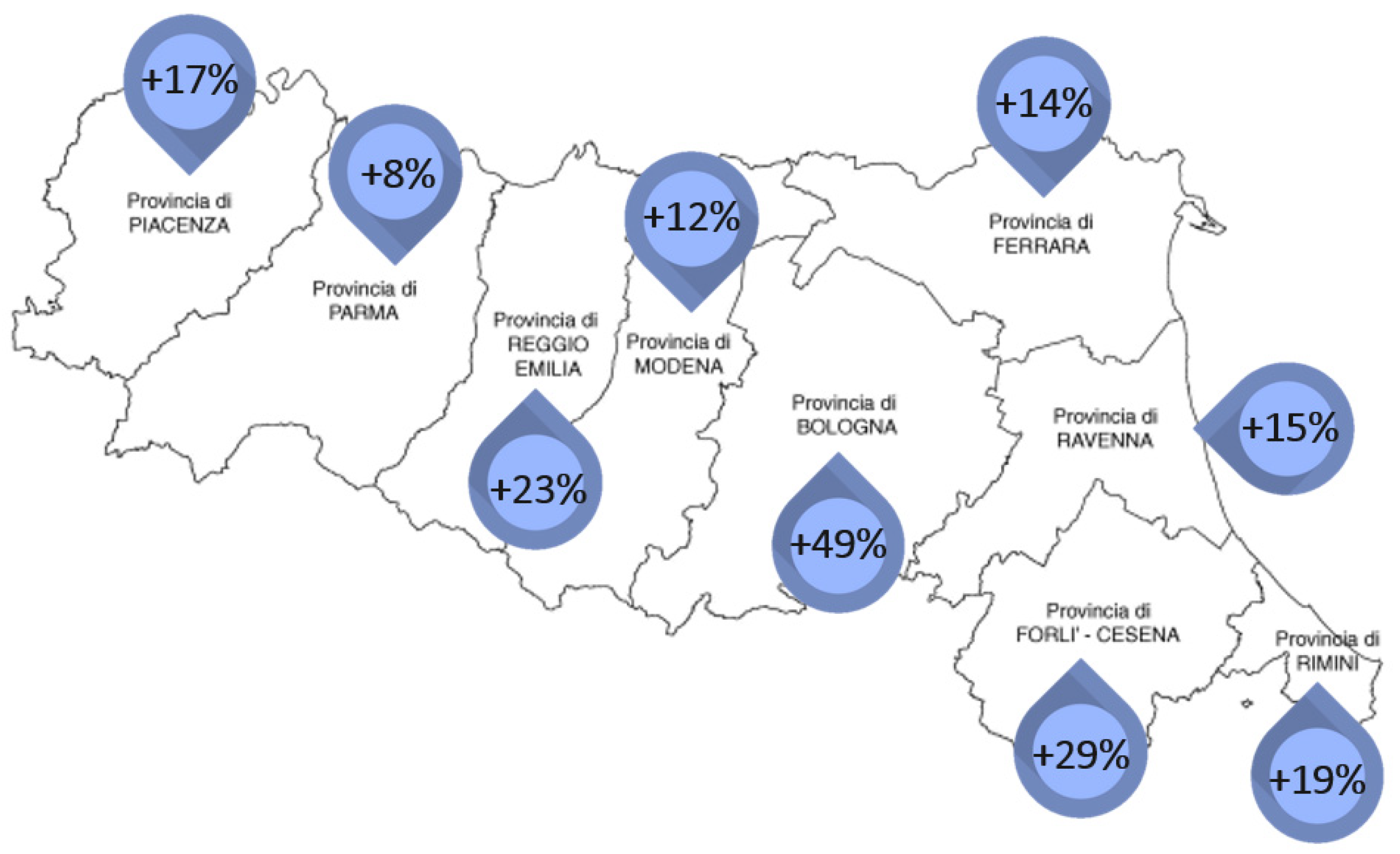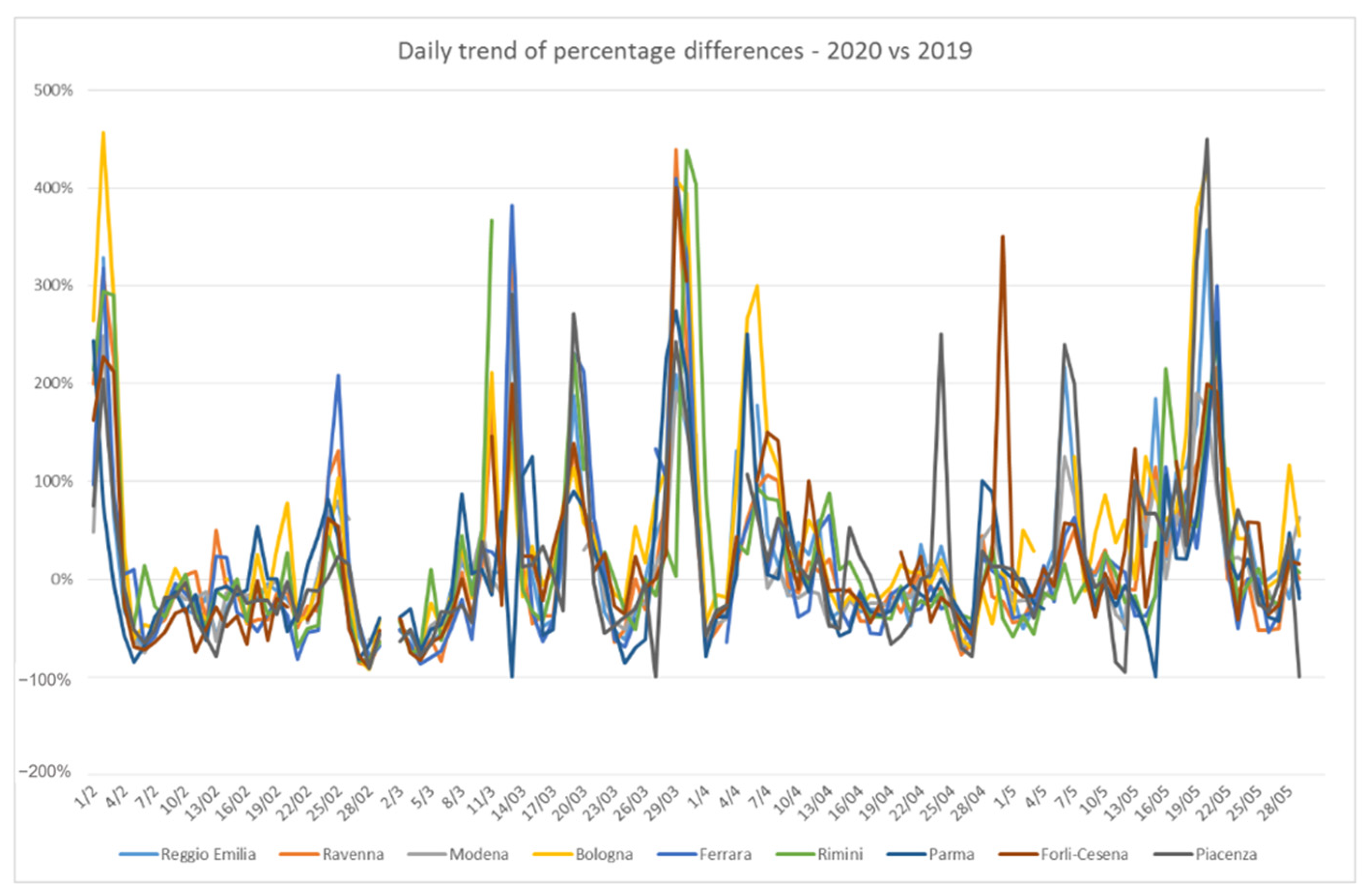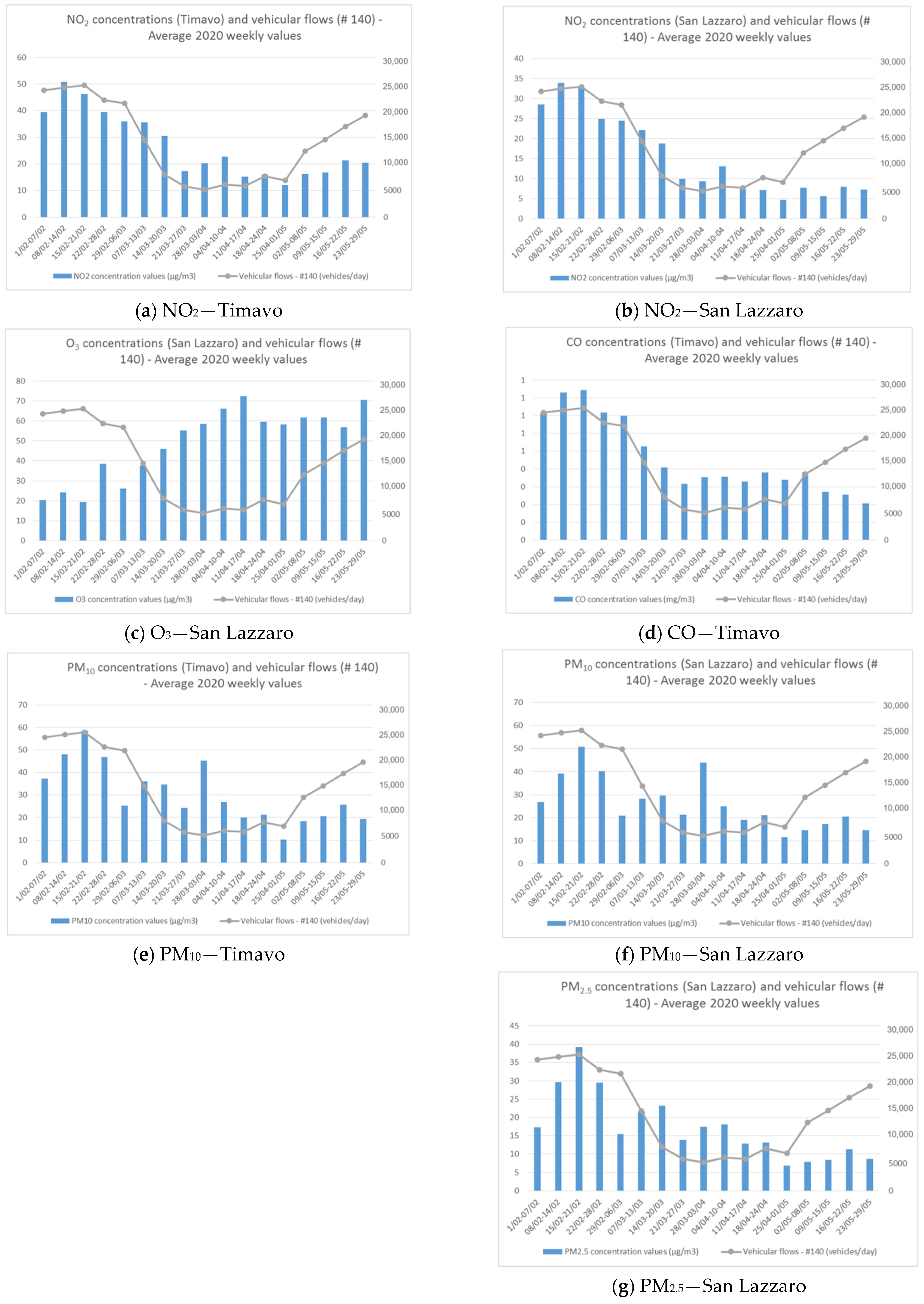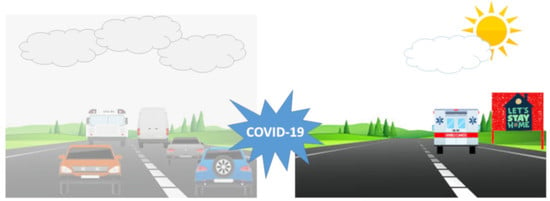The results highlight the sharp reduction in citizens’ movements compared to most of the sectors analysed, with particular significance for retail and recreation and transit stations (reduction of between −62% and −66%). Grocery and pharmacy, on the other hand, had fewer reductions (about −34%). Movements in the residential sector increased by around 22%. No significant differences are highlighted between the three different territorial areas reported. Parks in Reggio Emilia had a lower drop compared to the national situation (−45% compared to −51% in Italy).
3.3. Air Quality Results
The air quality results described in this section refer to the analysis of the data collected by the two AQMSs present in the study area.
Table 8 shows the annual average values of the main air pollutants detected, as well as the percentage difference of the data referring to the year 2020 compared to the period 2015–2019. From these results it is possible to observe a general reduction in 2020 of NO
2 and PM
10 at both AQMSs analysed. CO also decreases. However, there are increases for O
3 and PM
2.5, detected only at the “San Lazzaro” station.
The representation of the daily average values of the concentrations is shown in
Figure 7a–g, comparing the years 2019 and 2020, while
Table 9 shows the minimum, average and maximum values, the correlations in the data series and the percentage difference between 2019 and 2020. The percentage difference is also reported for the specific duration of the lockdown in Italy (10 March—18 May) in order to highlight the changes in concentrations for that specific period.
NO
2 assumed a generally decreasing trend during the period under investigation, going from average values of 50 µg/m
3 and 35 µg/m
3 (respectively for the “Timavo” and “San Lazzaro” stations) during the first days of February to values of 30 µg/m
3 and 18 µg/m
3 during the months of April and May. The trends shown in
Figure 7a,b show a general trend towards higher values during 2019 than in 2020. This is also confirmed in the average and maximum values shown in
Table 9, where the year 2020 has lower values. In the minimum values, 2020 is moderately higher than in 2019. The correlations are close to the optimal values in the comparison of the 2019–2020 data series. The comparison between the stations is less satisfactory.
Analysing the percentage differences, NO
2 is the only one of the pollutants analysed that has negative values, identifying a general decline in concentrations during the year 2020 compared to the previous year. Over the entire period analysed, “Timavo” recorded a general decrease of −32% (−41% during the lockdown) and “San Lazzaro” decreased by 41% (−52% during the lockdown). These results are in line with the recent available bibliography. In particular, [
54], studying the situation in western Europe, report a reduction in NO
2 concentrations of around 30%. Similarly, studies by [
26,
55,
56,
57] report reductions of about 50–60%, 36%, 35% and 25% in Spain, Peru, India and the USA, respectively.
O
3 is a pollutant detected only at the “San Lazzaro” station. It assumes an increasing trend over time (
Figure 7c). Being a pollutant with a strong dependence on the seasons, its values tend to increase going from the cold to the warm period. The daily trend of the concentration values highlights numerous situations with higher values in 2020 than in 2019, a superiority that can be identified in
Table 9, where the minimum, average and maximum values are always higher in 2020 than in the previous year. On average, the concentrations in 2020 are 13% higher than those in 2019 (+16% considering only the lockdown period). Other authors also report an increase in O
3 concentrations: [
58] describe a 17% increase in Europe, [
59] one of 30% in Brazil and [
60] an increase of 17% in India.
The CO is measured only at the “Timavo” station. Its performance (
Figure 7) gradually decreases from February to May, with a general good correlation between the two years (0.76). There is a general superiority of the values for 2019, as confirmed also by
Table 9. The percentage difference is −22% during 2020 compared to 2019. This percentage reaches −25% if we consider only the duration of the lockdown. Similar results are described by [
61] for Asia (−28%), by [
62] for India (−30%) and by [
63] for Brazil (−40%).
For PM10, the concentration trends are very similar at the two stations analysed. Both in “Timavo” and in “San Lazzaro”, the minimum, average and maximum concentrations for the period are similar. Even between the years 2019 and 2020 the values are not very different. Only the minimum values change between 2019 (with lower values) and 2020 (with higher values). The correlations in the concentration values detected during the same year between the two stations are very high (0.96 and 0.95 for 2019 and 2020, respectively). The correlations between different years (2019 compared to 2020) are much lower (0.44 and 0.51, respectively).
Despite the general trend towards lower concentrations going from February to May, the percentage differences in concentrations show an overall increase in PM10 concentrations for both stations analysed during 2020, compared to the concentrations measured in 2019. The mean values of percentage differences are 27% and 23% for “San Lazzaro” and “Timavo”, respectively. Comparing only the lockdown period, the percentage difference increases, reaching values of 43% and 37%.
Fine particulate matter (PM2.5) is a pollutant measured only at the “San Lazzaro” station. PM2.5 has very similar daily average trends to PM10 over the entire period, with an equal average value for both years (17 µg/m3). On the other hand, the minimum values (0.6 µg/m3 in 2019 and 4 µg/m3 in 2020) and the maximum values (76 µg/m3 in 2019 and 58 µg/m3 in 2020) change. The correlation is 0.58. Analysing the percentage differences, PM2.5 shows a general increase in values during 2020, with values higher than those recorded for PM10: +31% for the entire period analysed and +46% considering the lockdown period only.
While registering a reduction, the particulate matter remains within the variability of the previous year, with a different trend compared to the trend of gases. It is important to emphasize that the Emilia-Romagna area was strongly affected by the phenomenon of a long-term influx of dust from the Caspian Sea during the final days of March 2020, affecting the concentrations of dust in the whole area.
These results obtained for the particulate matter are in contrast to the indications provided by the international literature. Indeed, many studies have identified a reduction in particulate matter concentrations, both of PM
10 and PM
2.5 [
61,
64,
65]. To better understand this deviation, scientific studies on the behaviour of particulate matter in northern Italy during the COVID-19 emergency have been selected. Also, in this case, the results obtained are conflicting. Ref. [
66] studied the specific situation of the city of Brescia, observing how PM
10 concentrations have no significant variations, attributing the cause to a “balance” between the reduction of emissions due to the decrease in vehicular traffic and a consequent more intensive use of home heating. Furthermore, this result is justified by the contribution of the secondary particulate matter (very relevant in the Po Valley) and by the specific meteorological and climatic conditions that characterize this area.
On the other hand, [
67] studied the specific situation of the city of Milan, identifying a drop in concentrations of PM
10 (about −36%) and PM
2.5 (about −40%), attributing the cause to the reduction in vehicular traffic.
Finally, [
68] confirm the tendency for particulate matter concentrations to decrease during the lockdown (about −45% and −47% for PM
2.5 and PM
10, respectively), but without providing a comparison with pre-2020 years.
This situation highlights the characteristic complexity of atmospheric PM, which is strongly influenced by various factors, such as primary emissions, precursor emissions, weather and climate conditions that influence the transport and dispersion of the PM and activate photochemical processes for the formation of secondary particulate matter.
To investigate this uncertainty related to atmospheric particulate responses during the lockdown, additional verification has been conducted in this study. For each provincial area of the Emilia-Romagna region (a total of nine provinces) an AQMS classified as “urban traffic” has been selected and the percentage differences in PM
10 concentrations have been analysed during the period 1 February—31 May 2019 and 2020.
Table 10 shows the stations selected for each province, all in the urban area.
Figure 8 shows the average percentage differences for the period. The data have a general and widespread trend of higher PM
10 concentrations during the reference period 2020 compared to the same period of the previous year. All the AQMSs analysed have positive percentage differences between the two periods. The average values of the percentage differences vary between +8% for the urban area of Parma and +49% for the urban area of Bologna. Finally,
Figure 9 shows the temporal trend of the percentage differences, reporting the value referring to the comparison of the daily average values of PM
10. It is interesting to observe how the daily trends assume a similar trend among all the stations investigated.
Similar analyses are available for the main European cities thanks to the portal developed by the European Environment Agency [
69].
A study, published in ARPAE’s journal, analysed different air quality scenarios through mathematical models (in particular, the study applied two chemical and transport models: Ninfa-ER and Farm-PI), reconstructing the scenario with and without lockdown using the same input data and applying the specific meteorological conditions for spring 2020. The study confirmed that, with similar conditions, the effect of the lockdown on PM
10 concentrations in the Po valley would guarantee a median reduction of 15–30% [
70].
3.5. Lessons Learned for Future Land Management Practices
Poor air quality is a global problem that affects particularly heavily populated urban areas with a high presence of vehicular traffic, as well as industrial areas [
71]. Many policies and strategies are used globally to improve air quality and to reduce the health effects on the population due to exposure to high quantities of air pollutants. Among these, the control and reduction of traffic constitutes one of the most widespread practices and is realized through the updating of vehicle fleets in circulation with less impactful technologies and green fuels and through the solutions to modulate vehicle flows.
This aspect was deepened in the review prepared by [
72], which analyses the traffic management effects on emissions due to different strategies adopted in urban areas. The strategies it analyses are classified into operating restrictions and pricing, lane management, speed management, traffic flow control and trip reduction strategies.
The lockdown offered the opportunity to study a unique scenario, drastically reducing the circulating traffic and, in fact, applying several of the strategies above in an extreme and contemporary way. In addition to the transport sector, industrial emissions have also significantly decreased, while the impact associated with domestic heating has increased due to the greater time spent by the population in their homes.
In Italy, a widespread practice to reduce pollution in urban areas is represented by the partial and total temporary blocking of the most impactful circulating vehicles, so as to allow circulation only for greener vehicles (e.g., mono and bifuel methane-petrol vehicles, LPG—petrol, electric and hybrid). In Emilia-Romagna, these measures are adopted annually during the period 1 October—31 March and, at the same time, also involve domestic heating in addition to vehicular traffic. If the pollutant concentrations (PM
10 is used as a driver in choosing the activation of these emergency measures) exceed the legal limits for at least three consecutive days, the emergency measures are activated. This reactive approach helps to reduce concentrations of atmospheric pollutants within regulatory limits.
Figure 11a,b show the results of the activation of emergency measures in the urban area of Reggio Emilia in two recent periods, immediately preceding the COVID-19 emergency: 15, 16, 17 October and 10, 11, 12 December. The red box indicates the period imposed by the local authority to apply the emergency measures. The results reported for the two periods analysed show an immediate benefit in the reduction of PM
10 concentrations, which determines, in a few days, the end of the emergency measures. Concentrations, however, immediately tend to rise.
Therefore, in consideration of the effect observed by the restrictions imposed during the lockdown period and by observing the specific in-depth analyses presented to justify the contradictory result obtained for atmospheric PM, the lessons learned that can represent a contribution for future planning and management of the territory and air quality improvement are described as follows:
PM: Acting significantly on the reduction of circulating traffic and on the industrial sector (both responsible in Emilia-Romagna for emissions of about 37% of PM) may not be sufficient to reduce concentrations without simultaneous interventions in domestic heating and biomass combustion (which accounts for 51% of PM emissions). In addition, the strong dependence of PM on other factors that cannot be modified by man (meteorology and formation of secondary pollutants) makes this pollutant still difficult to manage. With these conditions, the reduction in overall traffic down to −82%, the reduction in industrial emissions and the increase in domestic heating have led to an increase in particulate matter of 27% and 31% (PM10 and PM2.5, respectively). By applying the same conditions to two alternative scenarios (with and without the lockdown effect), a reduction of PM of up to 30% has been estimated.
Intervening simultaneously in traffic and in domestic heating, on the other hand, determines an immediate benefit (albeit temporary for the duration of the restrictive actions), of up to 50%. This is the result observed during the activation of emergency measures.
NOx: The lockdown highlighted how direct action on traffic and industrial emissions (overall they contribute 78% of NOx regional emissions) has an immediate beneficial effect on the concentrations of this pollutant. The observed reduction was 32%. In this case, heating has a less significant effect (contributing to 8% of emissions).
CO: Has a behaviour similar to NOx, even if the lockdown has favoured a lower reduction (−22%) due to the higher incidence of domestic heating (41% of total emissions).
O3: As a secondary photochemical pollutant, the increase in temperatures and solar radiation, and a lower presence of NO in the atmosphere, determine a greater formation.
